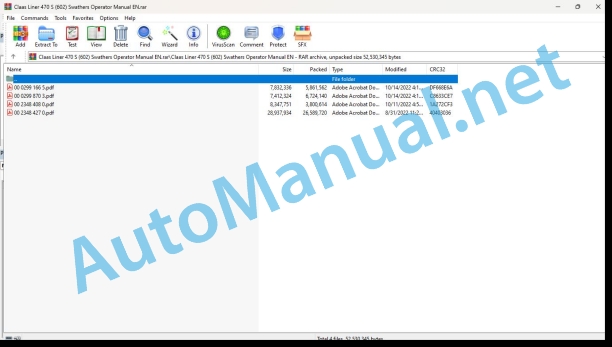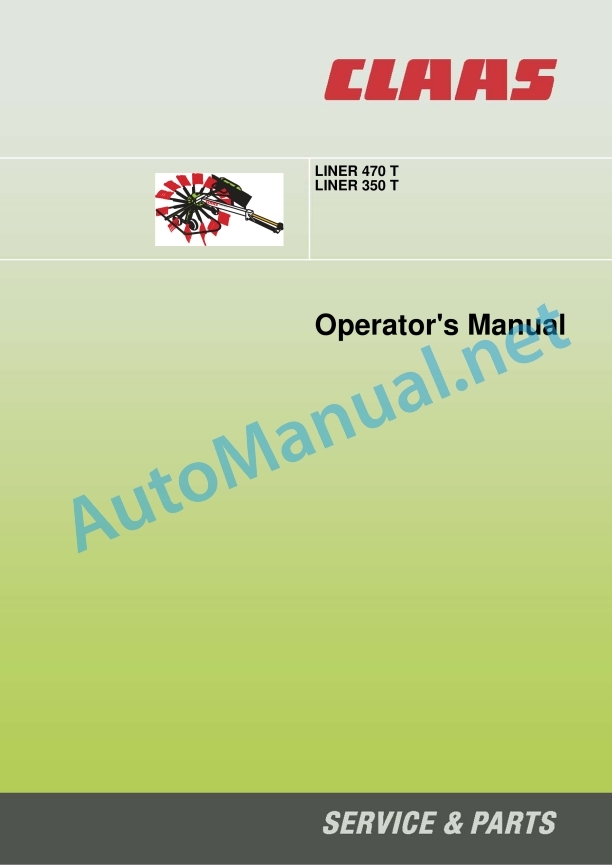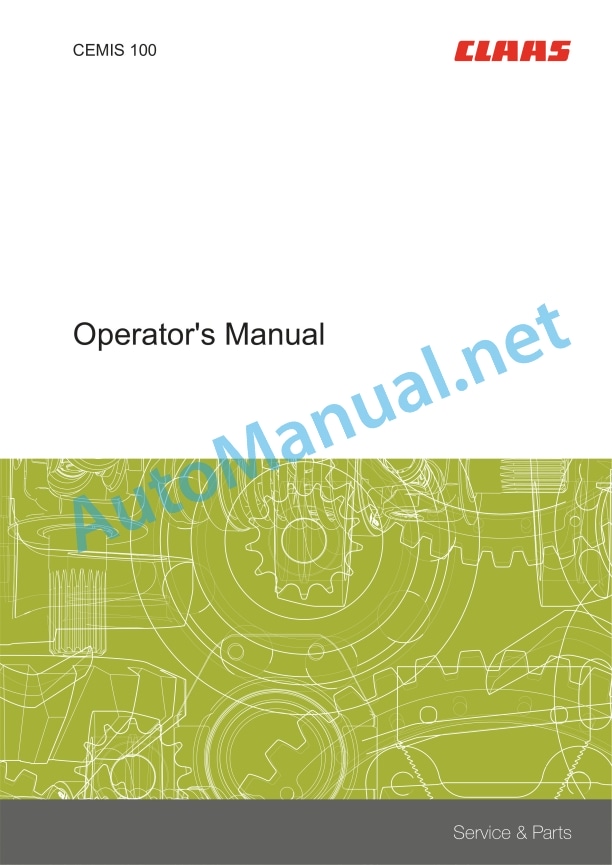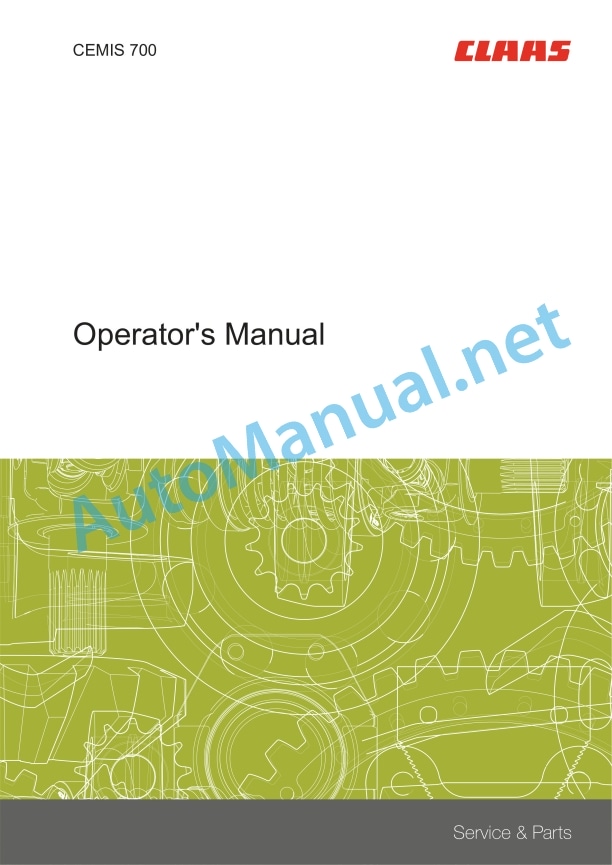Claas Liner 470 S (602) Swathers Operator Manual EN
$50.00
- Model: Liner 470 S (602) Swathers
- Type Of Manual: Operator Manual
- Language: EN
- Format: PDF(s)
- Size: 41.0 MB
File List:
00 0299 166 5.pdf
00 0299 870 3.pdf
00 2348 408 0.pdf
00 2348 427 0.pdf
00 0299 166 5.pdf:
Table of contents
1 To this operator’s manual
1.1 Notes on the manual
1.1.1 General instructions
1.1.2 Using the manual
Directions
1.1.3 Validity of manual
1.1.4 Symbols and notes
1.1.5 Technical specifications
2 Safety
2.1 Safety Tips
2.1.1 Particularly important
2.1.2 Qualification of drivers and maintenance personnel
2.1.3 Intended use
2.1.4 Reasonably foreseeable misuse
2.1.5 Safety and accident prevention regulations
2.1.6 First aid measures
2.1.7 Danger of injury by hydraulic liquid
2.2 Safety decals on the machine
2.2.1 Safety decals
2.2.2 Positioning on the machine
00 0514 946 1
00 0514 895 1
00 0514 897 1
00 0514 887 1
00 0514 896 1
3 Machine description
3.1 Overview and method of operation
3.1.1 Overview of LINER 470 T / 350 T
3.1.2 Function of machine
3.2 Options
3.2.1 Front sensing wheel (R03 0070)
3.2.2 Lighting adapter – USA (R03 0500)
3.2.3 Hydraulic connector for tractor (R03 0020)
3.2.4 Yoke kit (M03 0020)
3.2.5 Warning plate kit – France (S03 0160)
3.2.6 Warning plate kit – Italy (S03 0020)
3.2.7 SMV triangle (S03 0180)
3.3 Identification plates and identification number
3.3.1 Spare parts and technical questions
3.3.2 Machine identification plate
4 Operating and control elements
4.1 Drawbar
4.1.1 Crank
4.2 Hydraulic hose line
4.2.1 Shut-off tap
4.3 Rotor
4.3.1 Crank
5 Technical specifications
5.1 LINER 470 T
5.1.1 Dimensions
5.1.2 Weights
5.1.3 Tightening torque
5.1.4 Requirements for the tractor
5.1.5 Noise level
5.1.6 Design
5.1.7 Tyres
5.2 LINER 350 T
5.2.1 Dimensions
5.2.2 Weights
5.2.3 Tightening torque
5.2.4 Requirements for the tractor
5.2.5 Noise level
5.2.6 Design
5.2.7 Tyres
6 Machine preparation
6.1 Assembling the machine
6.1.1 LINER 470 T
6.1.2 Removing the transport packaging
6.1.3 Assembling the Contour chassis
6.1.4 Mounting the frame to the swathing gearbox
6.1.5 Assembling the drawbar
6.1.6 Installing the tension spring
6.1.7 Installing the stand
6.1.8 Installing the safety frame
6.1.9 Installing the windrowing rubber
6.1.10 Installing the tine bars
6.1.11 Installing the warning plates
6.1.12 LINER 350 T
6.1.13 Removing the transport packaging
6.1.14 Assembling the Contour chassis
6.1.15 Assembling the drawbar
6.1.16 Installing the tension spring
6.1.17 Installing the stand
6.1.18 Installing the safety frame
6.1.19 Installing the windrowing rubber
6.1.20 Installing the tine bars
6.1.21 Installing the warning plates
6.2 Adapting the machine
6.2.1 Universal drive shaft – Checking the length
Universal drive shaft – shortest operating position
Universal drive shaft – longest operating position
6.2.2 Universal drive shaft – Adapting the length
Universal drive shaft without seal at the female profiled tube
Universal drive shaft with seal at the female profiled tube
6.2.3 Fitting the universal drive shaft to the machine
Towing fastening
6.3 Hitching the machine
6.3.1 Hitching the drawbar
6.3.2 Installing the universal drive shaft
Safety fastening
6.3.3 Folding up the stand
6.3.4 Connecting the hydraulic hose
6.3.5 Connecting the electric system
6.4 Unhitching the machine
6.4.1 Swinging the stand down
6.4.2 Disconnecting the electric system
6.4.3 Disconnecting the hydraulic hoses
6.4.4 Removing the universal drive shaft
Safety fastening
6.4.5 Unhitching the drawbar
6.5 Preparing road travel – LINER 470 T
6.5.1 General safety precautions
6.5.2 Pushing the windrowing rubber to the inside
6.5.3 Folding the safety frame up
6.5.4 Removing the tine bars
6.5.5 Closing the shut-off tap
6.6 Preparing road travel – LINER 350 T
6.6.1 General safety precautions
6.6.2 Pushing the windrowing rubber to the inside
6.6.3 Closing the shut-off tap
7 Operation
7.1 General safety precautions
7.1.1 Prior to operation
7.2 Driving on the road
7.2.1 Driving on public roads
7.3 Fieldwork settings
7.3.1 Installing the tine bars
7.3.2 Adjusting the swathing rotors
7.3.3 Adjusting the windrowing rubber
7.3.4 Setting the working height
7.4 Fieldwork
7.4.1 Swathing
7.4.2 Fieldwork
8 Maintenance
8.1 Maintenance Information
8.1.1 General warnings
8.1.2 Electrical system
8.1.3 Protective guards
8.1.4 Spare parts
8.1.5 Unbalance
8.1.6 Compressed air and water
8.1.7 Burn prevention
8.1.8 Oils
8.1.9 Fire prevention and explosion prevention
8.1.10 Lines, tubes and hoses
8.2 Operating utilities
8.2.1 Lubricating oils and greases
8.3 Overview maintenance intervalls
8.3.1 Dealing with maintenance intervals
8.3.2 Before the harvest
8.3.3 After the first 10 operating hours
8.3.4 After the first 50 operating hours
8.3.5 Every 8 operating hours or daily
8.3.6 Every 20 operating hours
8.3.7 Every 50 operating hours
8.3.8 Every 250 operating hours or annually
8.3.9 Every 500 operating hours or annually
8.3.10 As needed
8.3.11 After the harvest
8.4 Maintenance operations in general
8.4.1 Cleaning the machine
8.4.2 Preserve the machine
8.4.3 Fastening material
8.5 Maintenance operations gearbox
8.5.1 Checking the semi-fluid lubricant filling – LINER 470 T
8.5.2 Checking the oil level – LINER 350 T
8.5.3 Changing the oil – LINER 350 T
8.6 Maintenance operations drive shaft
8.6.1 Maintaining drive shafts
General instructions for drive shafts
8.7 Maintenance operations clutch
8.7.1 Overload clutch
8.7.2 Over-run clutch
8.8 Maintanance operations chassis
8.8.1 Check the tyre pressure
8.8.2 Changing the wheel
8.8.3 Checking the wheel nuts tightening torque
8.9 Maintenance operations hydraulic
8.9.1 Hydraulic hose lines
8.10 Drawbar maintenance work
8.10.1 Adjusting the tension spring
8.11 Lubrication chart
8.11.1 Lubrication points – 8 h
8.11.2 Lubrication points – 20 h
8.11.3 Lubrication points – 50 h
8.11.4 Lubrication points – 250 h
9 Placing out of operation and disposal
9.1 General Information
9.1.1 Removal from service and disposal
10 EC-declaraction of conformity
10.1 LINER 470 T / LINER 350 T
10.1.1 EC Declaration of Conformity
11 Technical terms and shortcuts
11.1 Terms and explanations
11.1.1 Technical terms
11.1.2 Abbreviations
00 0299 870 3.pdf:
1 Basic components of the machine
2 Introduction
Introduction
Validity
3 Contents
4 Preface
Of special importance
Identification Plate
5 Safety Rules
Intended use
Avoidable incorrect applications
General safety regulations and safety precautions
De-commissioning and disposal
Identification of warning and hazard signs
Safety Decals with warning symbols
6 Technical data
LINER 470 S
LINER 430 S
LINER 390 S
LINER 350 S
Calculation of axle loads, minimum ballasting and total weight
Calculation of minimum ballasting at the front
Calculation of minimum ballasting at the rear
Calculation of the real front axle load
Calculation of the real total weight
Calculation of the real rear axle load
Tyre load carrying capacity
7 Assembly
Loading and unloading machine
Initial assembly of machine
Assembly Instructions
Mounting the warning panels
8 Prior to operation
Check every time prior to operation
Hitching up
Headstock
Universal drive shaft
Swath disc
Lowering the machine
Prior to transportation
Driving on public roads
Identification of the machine for road traffic
Warning plates with lighting
9 Operation
Field operation
Working position
Adjusting the swathing deflector
Height adjustment of the rotary assembly
Swath forming adjustment
Putting the swather to work
Transport position
Optional Equipment
3-point linkage – gauge wheel
Universal joint yoke kit
10 Maintenance
Important maintenance instructions
Wheels and tyres
Lubrication
Safety frame
Rotor gearcase
Swather gearbox LINER 470 S / 430 S / 390 S
Sealing the rotor gearcase
Clamping bearing – version with seal already applied
Clamping bearing – version without seal already applied
Swather gearbox LINER 350 S
PTO drive shaft
Screw connections
Spring tines
Fasteners
Cleaning and care
Winter storage
11 Lubrication chart
Safety precaution
Lubricating grease
Lubrication
00 2348 408 0.pdf:
CEMIS 100
Table of contents
1 Introduction
1.1 General information
1.1.1 Validity of the manual
1.1.2 Information about this Operator’s Manual
1.1.3 Symbols and notes
1.2 Intended use
1.2.1 Intended use
1.2.2 Reasonably foreseeable misuse
2 Safety
2.1 Safety rules
2.1.1 General safety and accident prevention regulations
2.1.2 Interaction between terminal and machine or tractor
2.1.3 Electrocution by electrical system
3 Product description
3.1 Overview and method of operation
3.1.1 Overview of CEMIS 100
3.1.2 Function principle of CEMIS 100
3.2 Identification plates and identification numbers
3.2.1 Spare parts and technical questions
3.2.2 Identification plate of CEMIS 100
4 Operating and display elements
4.1 CEMIS 100
4.1.1 User interface for LINER
4.1.2 User interface for ROLLANT
4.1.3 User interface for UNIWRAP
5 Technical specifications
5.1 CEMIS 100
5.1.1 Specification
6 Operation
6.1 CEMIS 100
6.1.1 Operating the CEMIS 100
6.1.2 Switching CEMIS 100 on
6.1.3 Switching CEMIS 100 off
7 Maintenance
7.1 CEMIS 100
7.1.1 Daily
8 Putting out of operation and disposal
8.1 General information
8.1.1 Removal from service and disposal
9 Technical terms and abbreviations
9.1 Terms and explanations
9.1.1 Technical words
9.1.2 Abbreviations
00 2348 427 0.pdf:
CEMIS 700
Table of contents
1 Introduction
1.1 General information
1.1.1 Validity of the manual
1.1.2 Information about this Operator’s Manual
1.1.3 Symbols and notes
1.2 Intended use
1.2.1 Intended use
1.2.2 Reasonably foreseeable misuse
2 Safety
2.1 Safety rules
2.1.1 General safety and accident prevention regulations
2.1.2 Interaction between terminal and machine or tractor
2.1.3 Electrocution by electrical system
3 Product description
3.1 Overview and method of operation
3.1.1 Overview of CEMIS 700
3.1.2 Function principle of CEMIS 700
3.2 Identification plates and identification numbers
3.2.1 Spare parts and technical questions
3.2.2 Identification plate of CEMIS 700
4 Information on the product
4.1 Software version
5 Operating and display elements
5.1 CEMIS 700
5.1.1 User interface
5.1.2 Terminal program
6 Technical specifications
6.1 CEMIS 700
6.1.1 Specification
7 Operation
7.1 CEMIS 700
7.1.1 Operating the CEMIS 700
7.1.2 Switching CEMIS 700 on
7.1.3 Switching CEMIS 700 off
7.2 Terminal settings
7.2.1 Making settings
Making settings with the rotary button
Making settings with the touch function
7.2.2 Setting the screen lighting
Daytime mode
Nighttime mode
Activating automatic key lighting
7.2.3 Setting the time and date
7.2.4 Displaying diagnosis information
On-board power supply voltage display
Display of CLAAS ISOBUS ECU address and name
7.2.5 Setting the language and display formats
Setting the language
Setting display formats
7.2.6 Setting the volume
7.2.7 Deleting an ISOBUS implement
8 Maintenance
8.1 Maintenance
8.1.1 Daily
9 Putting out of operation and disposal
9.1 General information
9.1.1 Removal from service and disposal
10 Technical terms and abbreviations
10.1 Terms and explanations
10.1.1 Technical words
10.1.2 Abbreviations
John Deere Repair Technical Manual PDF
John Deere Repair Technical Manual PDF
John Deere POWERTECH E 4.5 and 6.8 L Diesel Engines TECHNICAL MANUAL 25JAN08
John Deere Repair Technical Manual PDF
John Deere Repair Technical Manual PDF
John Deere Repair Technical Manual PDF
John Deere DF Series 150 and 250 Transmissions (ANALOG) Component Technical Manual CTM147 05JUN98
John Deere Repair Technical Manual PDF
John Deere Repair Technical Manual PDF
John Deere Application List Component Technical Manual CTM106819 24AUG20
John Deere Repair Technical Manual PDF
John Deere Transmission Control Unit Component Technical Manual CTM157 15JUL05
John Deere Parts Catalog PDF
John Deere Tractors 7500 Parts Catalog CPCQ26568 30 Jan 02 Portuguese
John Deere Repair Technical Manual PDF

























